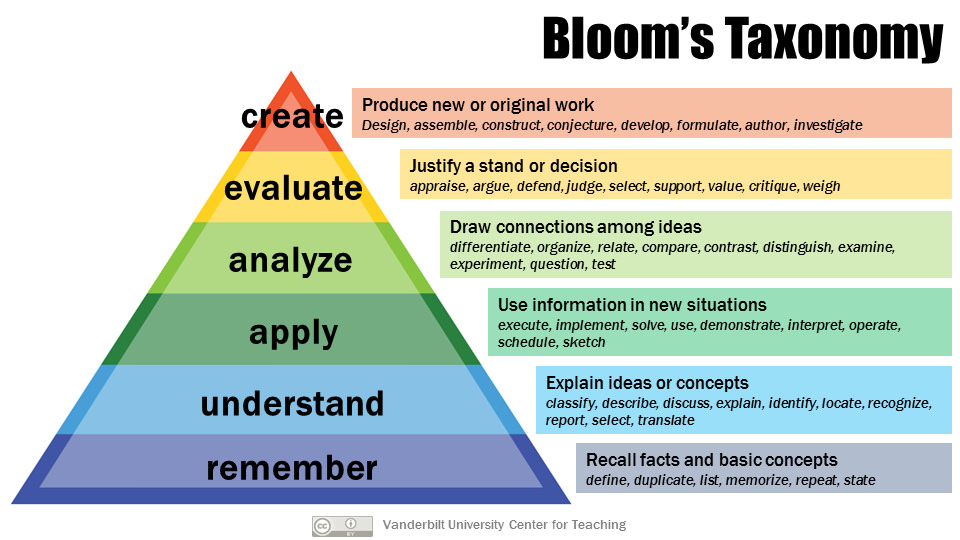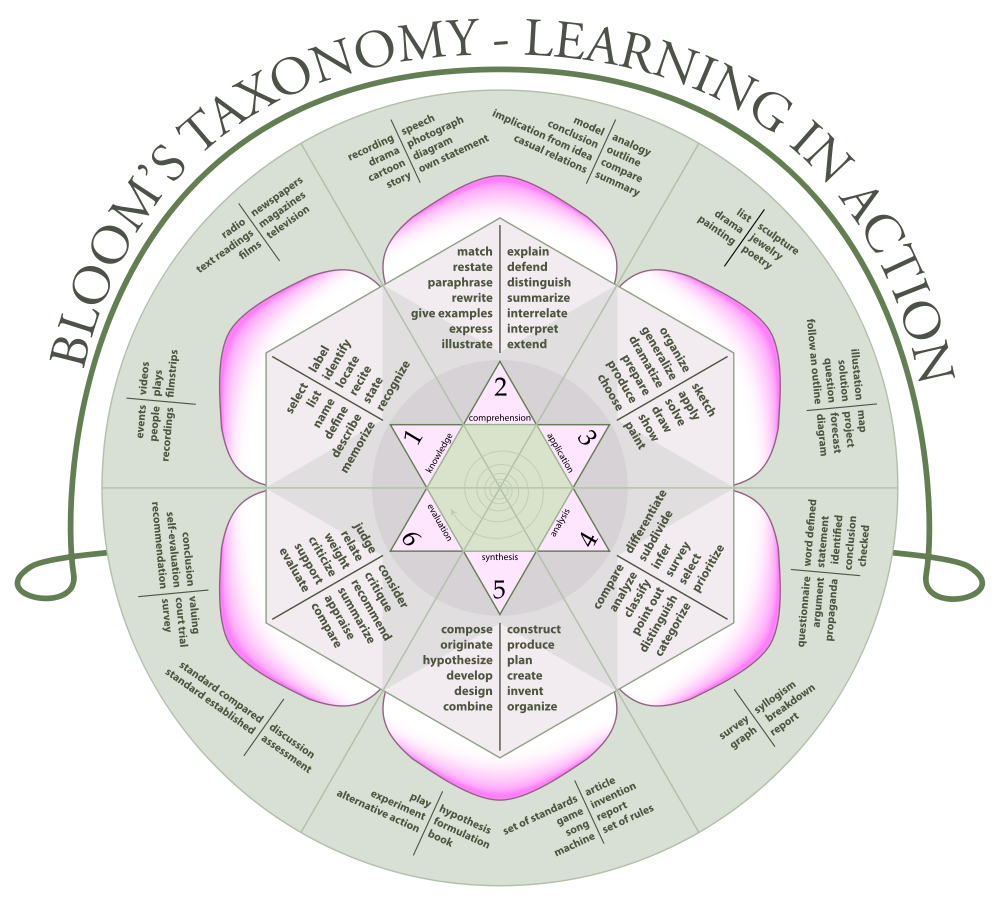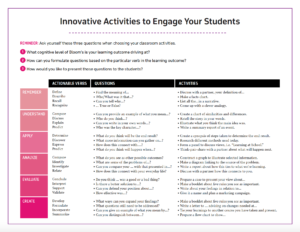Bloom’s Taxonomy is probably the most widespread and enduringly popular model in education. It was created in 1956 by Dr. Benjamin Bloom and colleagues at the Board of Examinations, University of Chicago. In 2001, the pyramid was revised by Lorin Anderson, a student of Bloom’s, resulting in Bloom’s Revised Taxonomy.

Bloom’s Revised Taxonomy focuses on learning outcomes. The framework demands that very first thing that instructors need to think about is what students have to know by the end of the course. Learning objectives need actions to get to them. And Bloom’s Revised Taxonomy is hierarchical, requiring your students to achieve each level in succession—in order to understand a concept, you must remember it; to apply a concept you must first understand it, and so on.
There’s no doubt that this way of classifying educational objectives has been extremely useful to millions of teachers over the years. But for those who might not have had conclusively positive results evaluating Bloom’s Revised Taxonomy or incorporating it into instruction, it’s worth considering some more ways to think outside the pyramid to improve teaching and learning. Here are three things you could bear in mind when using Bloom’s Revised Taxonomy in your lesson planning.
1. Cultivate judgment rather than transmit information
The instructional strategies behind Bloom’s Revised Taxonomy require educators to begin with “lower order” tasks, arguing that students need to master these first. This means we front-load our courses with information: information that can be recalled, defined, identified or another objective in the lowest layer of the pyramid.
But constructivist theories of learning—and our own classroom experiences—tell us that learning does not happen through information transference alone. A learner is an not empty vessel into which we pour definitions. He or she is not going to truly understand something without interpreting it, questioning it, or relating to it.
So when designing your course, try to incorporate ways to strengthen and take advantage of their faculties of judgment.
What would it mean to cultivate judgment during a course? Start by doing. Engage your students to take action in some relevant way—through a lab experiment, for example, or by field research. Another way to do this is role-play. When I taught history, we started out by taking on the identities of various countries, coming to decisions supported by research and analysis. The historical facts—and there were many—were all taught in this context. In this way, facts are put into the service of learning, rather than becoming an initial goal in themselves.
2. Start, rather than end, with creativity
As educator Shelley Wright has pointed out, Bloom’s Revised Taxonomy gives the impression there’s a “scarcity of creativity.”1 Only those strong enough or talented enough to work their way up to the summit of the pyramid can be creative. The truth is that everybody is naturally creative—just think of a seven year-old at play—except that this way of being in the world is often squelched or squandered. Ken Robinson, for instance, has strongly argued that creativity is typically “educated out” of us.2
What could it mean to start with creativity? Have your students create on day one. (OK, maybe day two or three.) Wright explains how this works for her media studies class. Instead of beginning by laying out design principles and the history of media, she gets the students to make an advert mockup. Then they compare their mockups to published adverts. Wright helps them analyze differences and introduces, through student-facilitated research, the major principles and concepts of design that help them explain their own creation and those of others.
A create-first approach could work just as well in courses that are theory-rich and fact-heavy such as philosophy, literature, or science. In environmental science, for example, ask students to propose a solution to deforestation or ocean acidification. Then, starting from their contributions, explore the principles, factors, concepts, contingencies at play, including the ones that were omitted. Have students compare their solutions to others’. Get them to elicit the principle involved, the recent literature in the area, and articulate and fully describe the concepts and the facts.
3. Promote awareness instead of entrenching hierarchy
The stratification of Bloom’s Revised Taxonomy into “lower” and “higher” order objectives sets up a value proposition. It leads educators to think that certain kinds of learning necessarily reflect superior kinds of cognition.
But as Roland Case argues, tasks at every level of Bloom’s Revised Taxonomy can be performed thoughtfully or thoughtlessly.3 It is possible to defend a position in a completely superficial way. It is possible to propose a plan that lacks good judgment or analysis. It is possible to create something without building from a base of relevant knowledge. Indeed, that is why it’s necessary to practice and develop judgment, critical thinking skills and creative problem-solving.
When Anderson and Krathwohl revised Bloom’s Taxonomy, they accounted for this with a second scale for assessment called The Knowledge Dimension, which lies as another dimension or axis to the cognitive domain. One should assess each of the revised categories (Remember, Understand, Apply, Analyze, Evaluate, Create) according to whether factual, conceptual, procedural or metacognitive knowledge is demonstrated.
If no category is higher or lower than any other, then leveling makes no sense. With proper consideration for The Knowledge Dimension, we are far from a pyramid… and always have been! But who knew? As Leslie Wilson points out, “what most educators are given in training is a simple chart listing levels and related accompanying verbs.”4
Bloom’s Taxonomy revised: A pyramid alternative
And so, if we want to engage students’ creativity, cultivate judgment and make sure that each stage of learning is fully developed and attuned to the right outcome, then organizing anew the existing structure of Bloom’s Revised Taxonomy could go a very long way. Instead of a pyramid, how about a mandala?

Strange things happen when we feel beholden to a structure. If lesson planning with Bloom’s Revised Taxonomy hasn’t been working for you or your class, rethink the background on how it should be applied. Reconsider the way you’re assessing student learning. Break down the hierarchy and rebuild.
Illustration credits: CC-BY 2.0 Vanderbilt University; CC-BY-SA 3.0 K. Aqinsqatsi.
Related stories
Bloom’s verbs and how to apply them to questions

Get a set of online teaching resources to help you develop effective teaching practices and foster active learning within your classrooms.
Download your free Top Hat Toolkit Here:
References
- Wright, S. (2012, May 15). Flipping Bloom’s Taxonomy [Blog post]. Retrieved from https://plpnetwork.com/2012/05/15/flipping-blooms-taxonomy/
- Parker, Q. (2018, October 3). The Possibilities of an Agile Classroom: Sir Ken Robinson [Blog post]. Retrieved from https://tophat.com/blog/sir-ken-robinson-qa/
- Case, R. Unfortunate Consequences of Bloom’s Taxonomy. Retrieved from https://tc2.ca/uploads/PDFs/Critical%20Discussions/unfortunate_consequences_blooms_taxonomy.pdf
- Wilson, L. O. (2017, January 20). Understanding the New Version of Bloom’s Taxonomy. [Blog post] https://thesecondprinciple.com/teaching-essentials/beyond-bloom-cognitive-taxonomy-revised/


